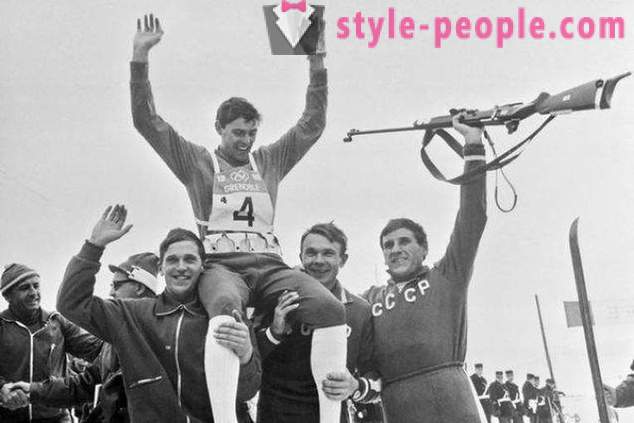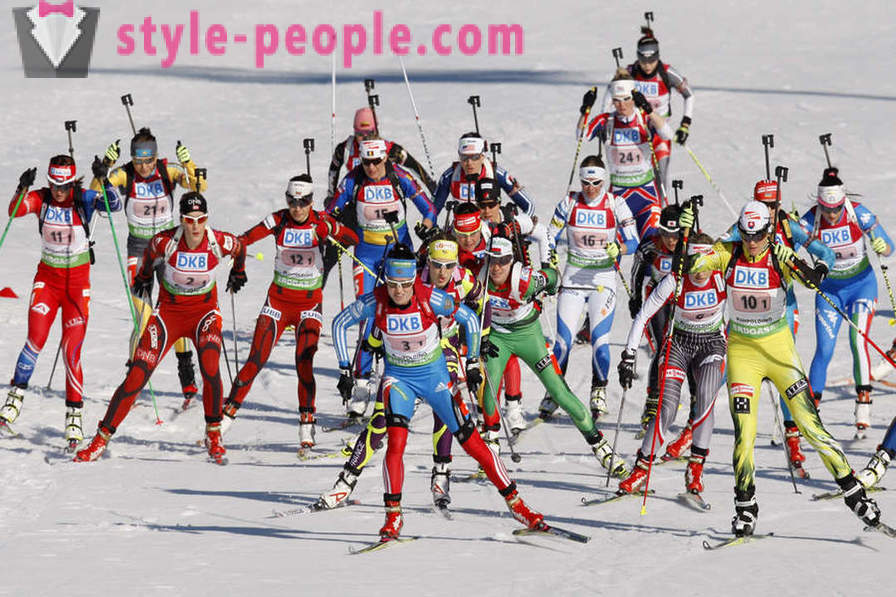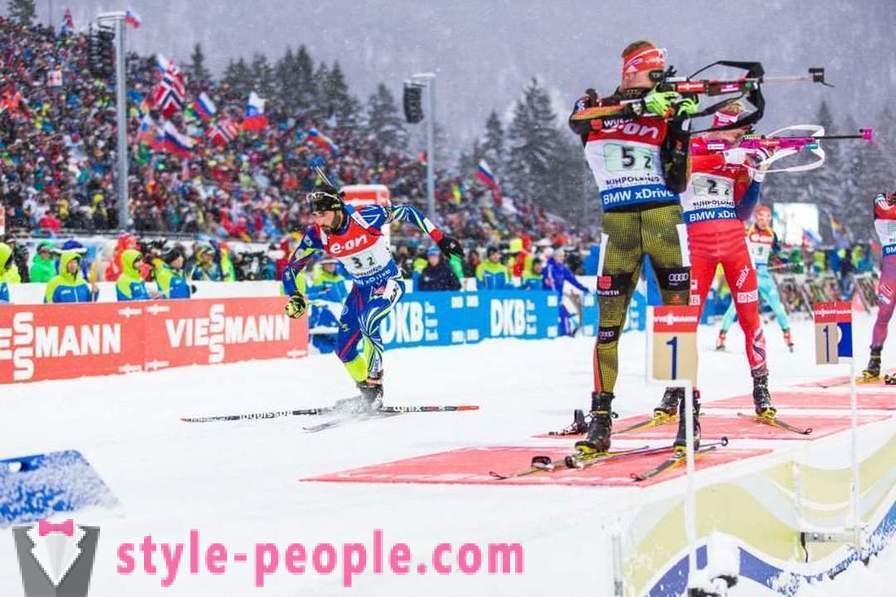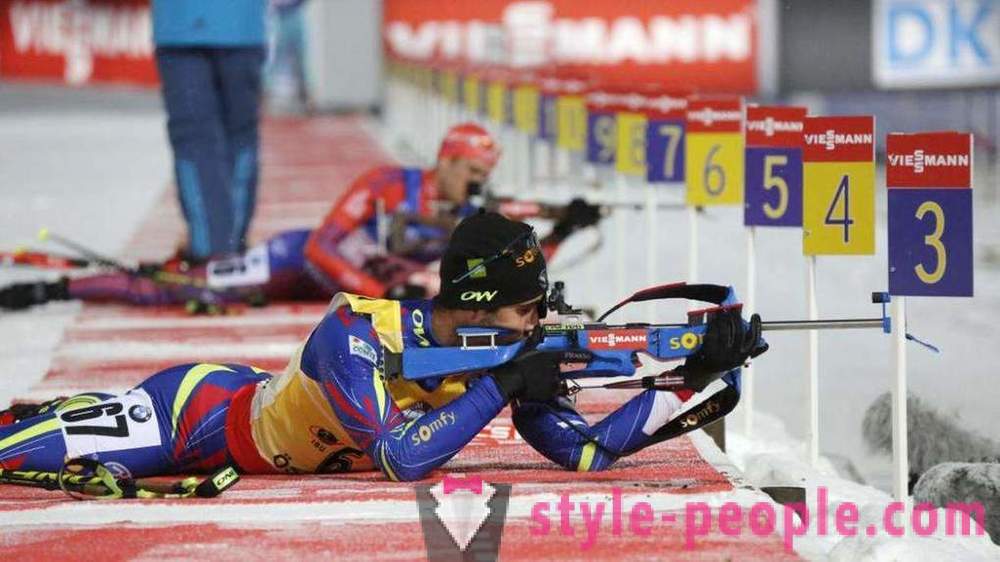Types biathlon history of origin, common rules and regulations of the biathlon sprint
Biathlon - one of the most popular winter sport in Russia and around the world. This mixture of cross-country skiing and small-bore rifle shooting from. This sport, like any other individual, has a competitive character. The winner is the athlete who came in first at the finish line or the fastest final time.
Briefly tell about the history and go directly to the heart of our topic - sprint in the biathlon.
The History of

Biathlon came about in 1767 through the border guards. Legend has it that the dispute Norwegian soldiers skied and shot the inhabitants of the forest. Who is faster and more to shoot, and he won. And the truth, what else to do in the winter evenings border guards?
World famous the sport was only in 1924 - a year of the first Winter Olympics. Initially it was called - "military patrol", but to be part of the Games, he was never able to. And in 1948, the Commission decided to delete altogether biathlon from all official competitions.
1954 was marked by the fact that the biathlon finally gained the recognition of the Olympic Committee, and after a further six years - and the status of an Olympic sport.
Originally biathlon was characterized as a male sport, timeless women. But in the fight against gender inequality first championship in women's biathlon was held in 1984.
In 1993 he created the International Biathlon Union and its headquarters. Since 1994 was the beginning of modern European championships, and in 1998 biathlon officially begins its independent existence.
General

In the biathlon used skating style of movement on skis. Skis and poles are selected for each individual. The main feature is the presence of a rifle. Its weight about 3, 5 kilograms. Imagine what it is - to drive a distance of 10 kilometers on skis with a rifle! This distance and just ski overcome hard, but there is also a weighting agent in the form of rifles.
Biathletes go on the firing line two or four times. The distance from which they shoot - 50 meters and a diameter of a target-only 45 millimeters in the prone position and 115 mm from a standing position. Athlete is given five rounds for each firing line except for the relay. In the relay, in case of a misfire, at biathlete has three spare rounds.
Types of races in biathlon

Total distinguish six varieties of passage of a line:
- Pursuit. It is based on the biathlon sprint. Upon completion of the sprint race, the athletes have individual temporary measure regarding the winner. The first 60 athletes in the final minutes of sprint fall into the following form, referred to as harassment. They will start on time, the loser to the winner of the race. On the firing line, they will have to look four times: the first two are made from a prone position, and the rest - standing. The winner is the one who crosses the finish line ahead of the rest.
- Mass Start. This is a race in which participants start moving en masse, ie together. It is attended by 30 of the best athletes in the general classification of the World Cup overall standings. Shooting is similar pursuit, and every mistake is punished by the penalty loop. The winner is the one who crosses the finish line first.
- Individual. It is considered one of the longest in the biathlon. Start athletes alternately at intervals of 0, 5 seconds to 1 minute. During the race, you need to call in four times at the shooting range, and, in contrast to the Pursuit and Mass Start, shooting is first lying, then standing, then lying down again and the last firing line - standing. Notable for this kind of fact that for every mistake an athlete receives a penalty in the form of adding one minute to the time of the race. Most often, the winner is the one who has not made mistakes in the firing line.
- relay - one of the most exciting types of competitions. Participation in it taking national teams from each country, who are already apply. Each athlete shoots twice, once - lying second, respectively, standing. Unlike the race from the others is that the athlete has three additional rounds in case he did not get the first time to one of the targets. If not, and additional help biathlon, its expected penalties.
- Mixed Relay. This is a relatively new type of program in the biathlon. Participation taking teams consisting of two women in the early stages and two men - on the next. Terms of shooting and penalties similar to the "classical" relay.
to
You probably will wonder if the six types, why then presents only five of them? But the sprints, we will pay special attention because it is the basis of all the biathlon battles. We proceed to a thorough analysis of these races.
Biathlon, Sprint Men and women

Sprint - a type of program that appeared one of the most recent. Sprint women Biathlon distance is 7, 5 kilometers with two firing lines. For men, this distance is 10 kilometers. As a rule, women race less complicated, but it can be hard climbs and dangerous descents.
Two firing line are arranged at the end of the first and second round. In the first shooting is made from a prone position. The athlete must fall in diameter at the target, or it is waited penalty loops, equal to the number of misses. The length of the penalty circle - 150 meters. The second firing is conducted from a standing position. Biathlete, arriving at the shooting range, the right to choose any shooting lane. And at the end of all the lines, he rushes to the finish circle. The winner is the one who shows the best time on the final segment.
As already mentioned earlier, as a result of the biathlon sprint selected 60 people to participate in the pursuit.
Biathlon - very entertaining and attractive sport. It develops in the athlete strength of mind and will. There are varieties and summer biathlon, but that's another story.













































